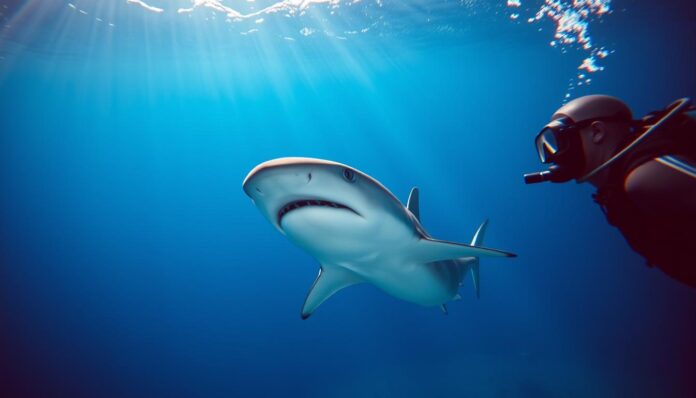Imagine seeing a creature that can be up to 20 feet long. It has a hammer-shaped head that lets it see all around. Great hammerhead sharks are a thrilling sight for those who love diving.
These sharks are not the scary monsters movies make them out to be. They usually don’t bother humans and like to stay away. Their special head helps them find food by smelling it from far away.
Places like Socorro Island in Mexico and Malpelo Island in Colombia are great for seeing these sharks. These spots are full of life and offer amazing dives for the brave.
Key Takeaways – Diving with Hammerhead Sharks
- Hammerhead sharks can grow up to 20 feet in length
- Multiple global locations offer unique hammerhead shark encounters
- Sharks are generally non-aggressive towards humans
- Their distinctive head shape provides exceptional hunting capabilities
- Diving with hammerheads requires proper safety guidelines
Understanding Hammerhead Sharks
Diving into the world of marine wildlife shows us nature’s most fascinating creatures. Hammerhead sharks are among the most interesting, with their unique looks and amazing abilities.
Hammerhead sharks are a unique group, with at least ten different species found worldwide. Their hammer-shaped heads make them easy to spot among other sea creatures.
Shark Species Diversity
The hammerhead shark family includes many interesting species:
- Great Hammerhead (Sphyrna mokarran)
- Scalloped Hammerhead
- Smooth Hammerhead
- Bonnethead Shark
Remarkable Physical Characteristics
These amazing sea creatures have impressive features:
- The great hammerhead can grow up to 20 feet long
- Females are usually 9 to 12 feet long
- Their special head shape helps them sense their surroundings better
“The hammerhead’s distinctive head is not just for show—it’s a sophisticated navigation and hunting tool.”
Diving and Behavioral Insights
When we explore the ocean, we see amazing hammerhead shark behaviors. They often swim together during the day, creating beautiful underwater scenes. Their ability to dive deep is impressive, with some staying underwater for up to 17 minutes.
Learning about these incredible creatures helps us appreciate and protect them. This is key to keeping our oceans healthy for future generations.
Best Locations for Hammerhead Shark Diving
Extreme diving fans looking for amazing shark experiences have top spots around the world. These places let you dive with hammerhead sharks in their home. It’s a chance to see some of the ocean’s most interesting creatures up close.
The world map for hammerhead shark diving shows many amazing places. Each spot has its own special features. They make diving with sharks unforgettable.
Top Global Hammerhead Diving Destinations
Asia:
- Maldives: The Maldives offers numerous dive sites where divers can encounter hammerhead sharks, particularly in the northern atolls such as Haa Alifu and Haa Dhaalu. The currents in these areas create ideal conditions for shark sightings.
- Cocos Island, Costa Rica: Located in the eastern Pacific Ocean, Cocos Island is renowned for its hammerhead shark encounters. Divers can witness large schools of hammerheads cruising along the underwater pinnacles and steep drop-offs.
- Raja Ampat, Indonesia: Raja Ampat is a biodiversity hotspot and home to an abundance of marine life. Divers can explore sites such as Misool and Dampier Strait, where hammerhead sharks can be spotted alongside other fascinating marine species.
- Socotra Island, Yemen: Socotra Island, situated in the Arabian Sea, offers an extraordinary diving experience with hammerhead sharks. The island’s remote location and nutrient-rich waters attract hammerheads, making it a prime destination for shark enthusiasts.
- Protea Banks, South Africa: Located off the east coast of South Africa, Protea Banks is renowned for its shark encounters. Divers can witness the spectacle of hammerhead sharks, along with other species like bull sharks and tiger sharks, against the backdrop of stunning underwater topography.
- Bimini, Bahamas: Bimini is known for its encounters with great hammerhead sharks, particularly during the winter months. Divers can join specialized shark diving trips and witness these majestic creatures in their natural environment.
- Galapagos Islands, Ecuador: The Galapagos Islands offer a unique opportunity to encounter scalloped hammerhead sharks in large numbers. Divers can explore iconic sites like Darwin and Wolf Islands, where hammerheads form impressive aggregations.
- Coiba National Park, Panama: Coiba National Park is a UNESCO World Heritage Site and a haven for hammerhead shark encounters. Divers can explore the pristine waters surrounding Coiba Island and witness these magnificent creatures cruising in the currents.
- Isla del Coco, Costa Rica: Isla del Coco, located in the Pacific Ocean, is a renowned destination for hammerhead shark diving. Divers can experience thrilling encounters with scalloped hammerheads, as well as other pelagic species like whale sharks and manta rays.
- Azores, Portugal: The Azores archipelago in the Atlantic Ocean offers the opportunity to dive with scalloped hammerhead sharks. The best chances for encounters are around the islands of Pico and Faial, where divers can witness the beauty of these sharks in the crystal-clear waters.
- Great Barrier Reef, Australia: The Great Barrier Reef is not only a UNESCO World Heritage Site but also a hub for diverse marine life. Divers can explore dive sites such as Osprey Reef, where they have a chance to encounter hammerhead sharks amidst the stunning coral formations.
- Revillagigedo Islands, Mexico: The Revillagigedo Islands, also known as the Socorro Islands, offer thrilling encounters with hammerhead sharks. Divers can witness schools of these majestic creatures alongside other pelagic species in the deep blue waters of the Pacific.
- Malpelo Island, Colombia: Malpelo Island is a remote and protected marine reserve famous for its hammerhead shark encounters. Divers can expect to witness large schools of hammerheads, making it a bucket-list destination for shark enthusiasts.
Please note that dive conditions, accessibility, and the presence of hammerhead sharks can vary based on factors such as seasonality and environmental changes. It is always recommended to consult with local dive operators and consider expert guidance when planning a dive trip to these destinations.
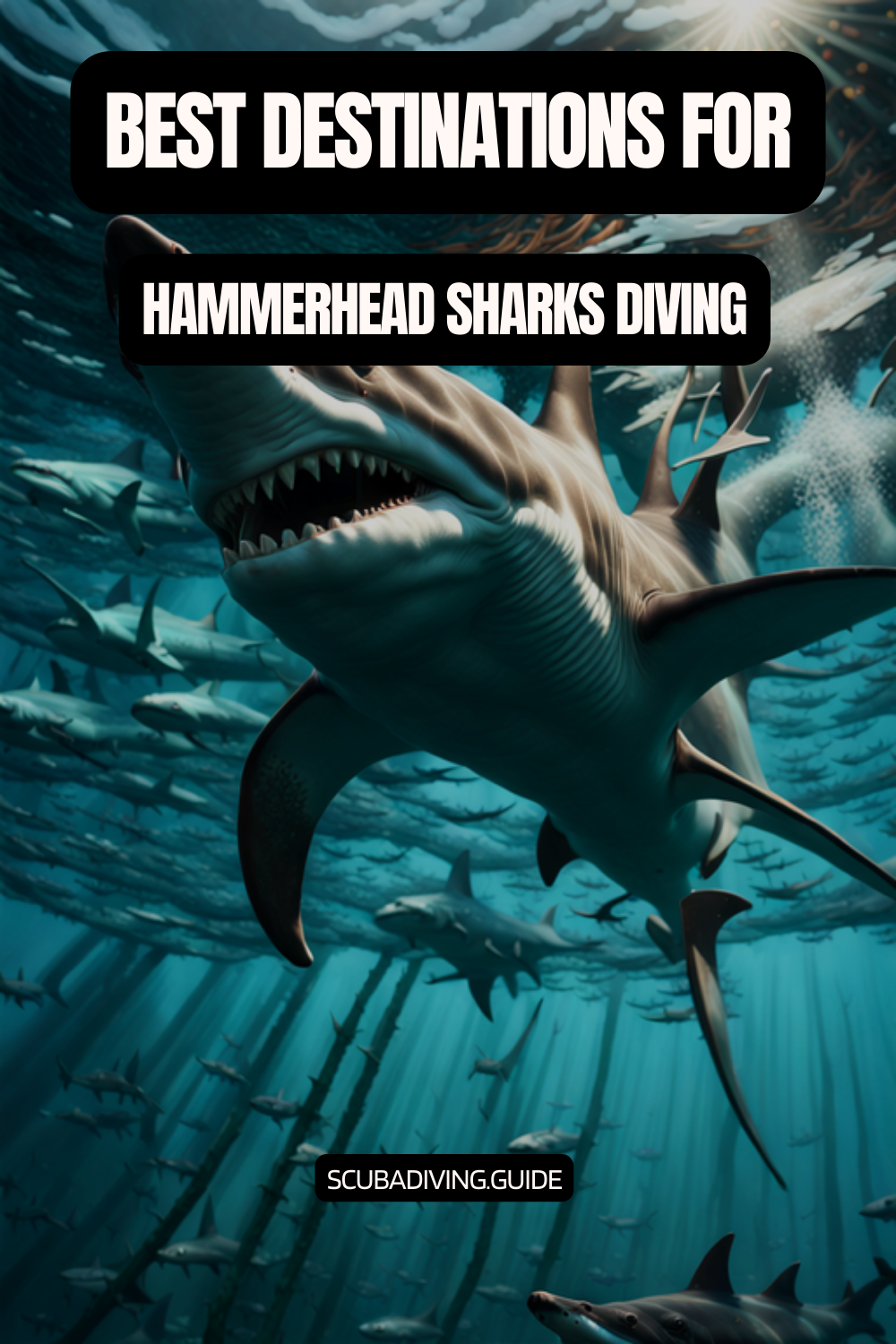
Seasonal Considerations for Shark Encounters
When planning dives to see hammerhead sharks, timing is everything. Each place has its own best time for spotting sharks. This is because of the different seasons and how they affect shark activity.
“The magic of hammerhead diving lies not just in the destination, but in understanding the rhythms of these magnificent marine creatures.”
| Location | Best Months | Unique Characteristics |
|---|---|---|
| Maldives | January – March | Remote southern atolls |
| French Polynesia | January – February | Huge schools of marine life |
| Seychelles | March-May, October-December | Diverse marine ecosystem |
To have a great shark encounter, you need to plan well. Know the local sea conditions and pick the right time. Doing your homework is essential for a memorable dive.
Equipment Needed for Hammerhead Shark Diving
Getting ready for scuba diving with hammerhead sharks means picking the right gear. The right equipment can turn a dive into an amazing experience.
Choosing the right gear for underwater adventures is key. Divers need to think about several things when picking out their equipment for hammerhead shark dives.
Recommended Diving Gear
- Wetsuit or drysuit for the water temperature
- High-quality regulator for deep dives
- Dive computer for tracking depth and time
- BCD (Buoyancy Compensation Device) for reliable inflation
- Dive weights for the right underwater position
Photography Equipment for Capturing Memories
To capture the magic of diving with hammerhead sharks, you need special underwater photography gear:
- Waterproof camera housing
- Wide-angle lens for shark movements
- Underwater strobe lights
- Extra battery packs
- Lens cleaning kit
“The right equipment transforms an ordinary dive into an extraordinary underwater adventure.” – Professional Marine Photographer
Remember the rule of thirds for air supply management. Save one-third for going up, use one-third during the dive, and keep the last third as a safety backup.
Essential Safety Considerations
- Avoid wearing reflective jewelry
- Use a buddy system
- Check equipment before each dive
- Maintain calm and controlled movements
Investing in quality gear ensures a safe and memorable experience. It lets you explore the fascinating world of hammerhead sharks.
Safety Tips for Diving with Hammerhead Sharks
Scuba diving with hammerhead sharks needs careful planning and a good grasp of marine safety. These encounters can be exciting, but we must dive responsibly. This means knowing how to interact with these amazing creatures.
Shark encounters are rare. In 2022, there were only 108 shark-human interactions, with just 57 being unprovoked attacks. Knowing how to stay safe can reduce risks when diving with hammerhead sharks.
Pre-Dive Preparations
Getting ready for scuba diving with hammerhead sharks is key. Important steps include:
- Complete a thorough diving fitness check
- Take shark encounter training
- Check your gear works well
- Learn how to communicate in emergencies
In-Water Safety Guidelines
Here are vital safety tips for diving with hammerhead sharks:
- Keep at least 10-15 feet away from sharks
- Avoid sudden moves to prevent sharks from getting scared
- Wear neutral-colored diving gear to avoid being mistaken for prey
- If a shark comes near, stay calm and move slowly
“Safety in shark diving is not about fear, but about respect and understanding.” – Marine Biology Expert
By following these tips and diving responsibly, we can have safe and memorable dives. This way, we can enjoy hammerhead shark encounters without risks.
The Best Time of Year to Dive with Hammerheads
Planning shark encounters needs careful thought about when and where to dive. Hammerhead shark diving is thrilling but depends on timing and location.
Different places offer great chances to dive with these amazing sharks. Knowing when they move can make your dives unforgettable.
Seasonal Migration Patterns
Hammerhead sharks have interesting migration patterns worldwide. Key spots for diving with them include:
- Galapagos Islands: Peak season from January to May
- Bahamas: Best diving from December to February
- Cocos Island: Large schools visible May to November
- French Polynesia: Prime diving December to April
- Maldives: Optimal sightings December to April
Weather Considerations
Diving with hammerhead sharks means knowing the local weather and sea conditions. The temperature and currents affect shark behavior and safety.
| Location | Water Temp (°C) | Best Months | Visibility |
|---|---|---|---|
| Galapagos | 20-25 | Jan-May | Excellent |
| Bahamas | 24-27 | Dec-Feb | Good |
| Maldives | 27-29 | Dec-Apr | Very Good |
“The magic of hammerhead diving lies not just in seeing these creatures, but in understanding their world.” – Marine Biologist
Professional divers suggest checking with local dive operators for the latest seasonal tips. This will help you prepare for your shark encounters.
Hammerhead Shark Conservation Efforts
Marine conservationists worldwide are working hard to protect hammerhead sharks. These unique predators face many challenges that threaten their survival. Studies show that about one-third of shark and ray species are at risk of extinction.
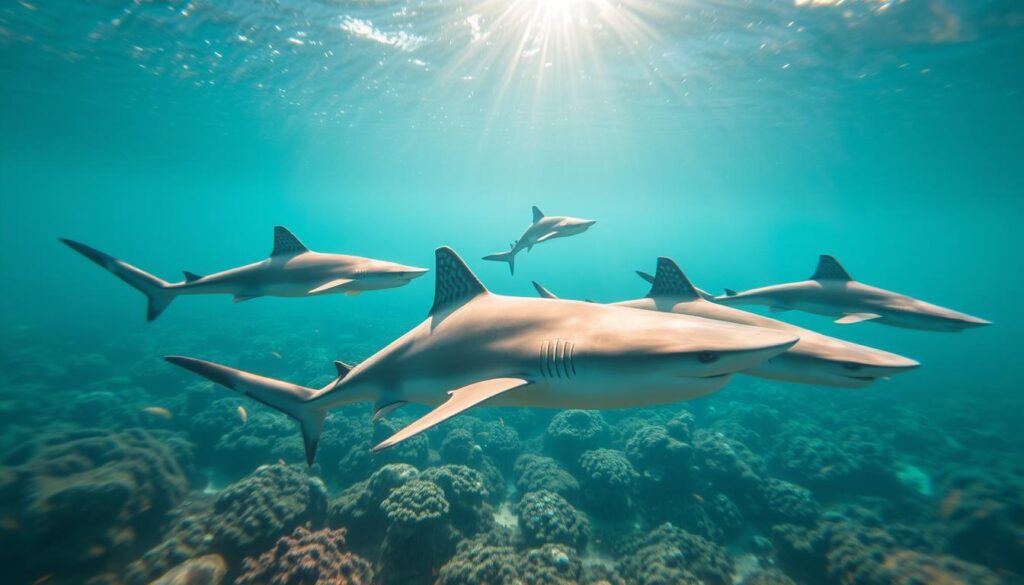
The situation for hammerhead sharks is very concerning. Many species are in critical danger:
- 4 species are Critically Endangered
- 2 species are Endangered
- 1 species is Vulnerable
- 1 species remains Data Deficient
Importance of Protecting Hammerheads
Healthy shark populations are key to marine ecosystems. Hammerhead sharks help keep the ocean diverse. Their decline is a big threat to the ocean’s balance.
“Protecting hammerhead sharks is not just about saving a single species, but preserving entire marine ecosystems.” – Marine Conservation Expert
How Divers Can Help
Eco-tourism is a powerful tool for conservation. Divers can make a difference in several ways:
- Participate in citizen science projects
- Support marine protected areas
- Choose responsible dive operators committed to conservation
- Spread awareness about shark conservation
| Conservation Initiative | Impact |
|---|---|
| PADI AWARE Foundation | Aims to reduce shark extinction risk by 25% by 2030 |
| CITES Appendix II Listing | All hammerhead species protected internationally |
| Great Barrier Reef Protection | Expected 50% reduction in shark catch by 2024 |
Divers can make a big difference by supporting conservation. This helps protect these amazing creatures for the future.
Dive Schools and Tours for Hammerhead Diving
Planning a scuba diving trip with hammerhead sharks needs careful thought. You must pick the right dive operator. The world has amazing spots to see these incredible creatures while being eco-friendly.
Choosing the right dive school is key. It ensures a great experience and helps protect the sea.
Selecting a Reputable Dive Operator
Look for a dive operator that specializes in hammerhead sharks. Here are important things to check:
- Proven safety record
- Expert marine biologists on staff
- Commitment to ecological preservation
- Advanced underwater navigation skills
- Small group diving policies
Dive Package Options
There are many package types for hammerhead shark dives:
| Package Type | Duration | Best Locations |
|---|---|---|
| Day Trips | 6-8 hours | Baja California, Bahamas |
| Liveaboard Expeditions | 3-10 days | Galapagos, Cocos Island |
| Specialty Photography Tours | 5-7 days | Maldives, Red Sea |
“Responsible diving is about respecting marine ecosystems while creating unforgettable underwater experiences.” – Marine Conservation Expert
Each place offers unique hammerhead shark experiences. Malpelo Island has schools of up to 200 sharks. Cocos Island has massive walls of hundreds of sharks.
Preparing for Your Dive
Check your diving certification and fitness before booking. Some places, like Cocos Island, need advanced skills because of strong currents.
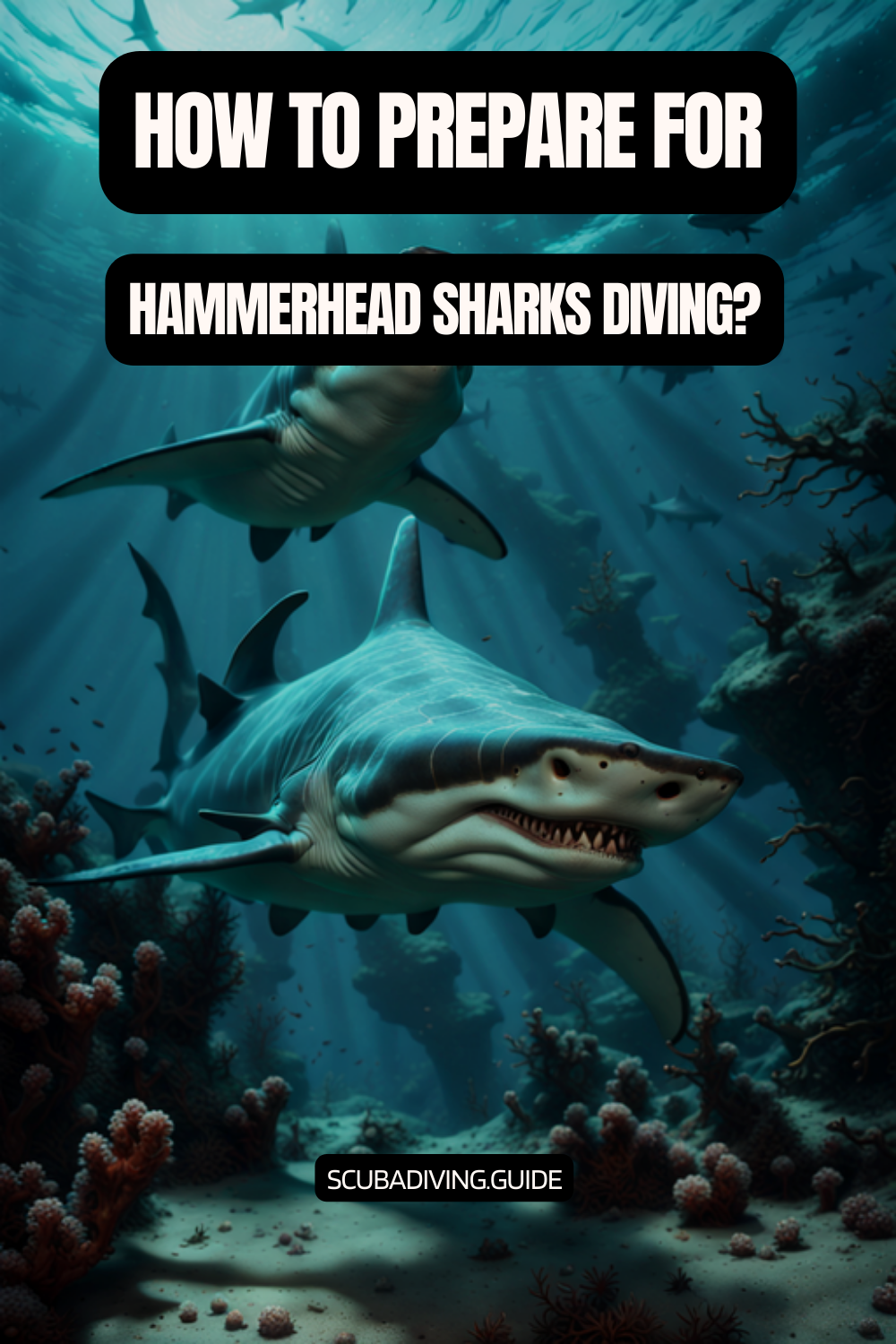
Scuba diving with hammerhead sharks is a unique journey. Choose your operator carefully, focus on safety, and follow eco-friendly practices for a memorable dive.
What to Expect During Your Dive
Shark encounters with hammerheads are thrilling. They turn diving into an adventure. You’ll feel the rush of adrenaline.
Diving with hammerheads is different everywhere. The Hammerhead Triangle is known for amazing shark sightings. Places like the Galapagos Islands offer unique dives.
Encountering Hammerheads in the Wild
Hammerhead sharks can be seen alone or in huge schools. Certain spots are famous for their shark behaviors:
- Cocos Island: Large schools visible July through August
- Galapagos Islands: Peak sightings from January to May
- Malpelo Island: Dramatic vertical walls with significant shark populations
Dive Experience Levels
Diving with hammerheads is not for beginners. You need:
- Advanced open water certification
- Excellent buoyancy control
- Comfort in challenging current conditions
“The ocean’s most extraordinary moments happen when you least expect them.” – Marine Exploration Digest
Water temperatures in top hammerhead spots are 16-25°C. This presents both challenges and amazing experiences. Divers often see 8-10 sharks in one dive, making it unforgettable.
Frequently Asked Questions About Hammerhead Diving
Scuba diving with hammerhead sharks is exciting for many. It’s a chance to see these amazing marine animals up close. Knowing about them helps divers get ready for a great underwater adventure.
Common Diving Concerns
Many divers feel a bit scared when they see hammerhead sharks. But, hammerhead sharks usually don’t bother humans. Here are some important facts:
- Hammerhead sharks rarely show interest in human divers
- Most encounters are peaceful and observational
- Proper diving techniques minimize possible risks
Myths vs. Facts
“Knowledge transforms fear into respect” – Marine Biology Professionals
Here are some common myths about these marine creatures:
- Myth: All sharks are dangerous predators
Fact: Hammerhead sharks are usually not a threat to humans - Myth: Hammerhead sharks attack randomly
Fact: They mainly hunt for marine prey, not humans
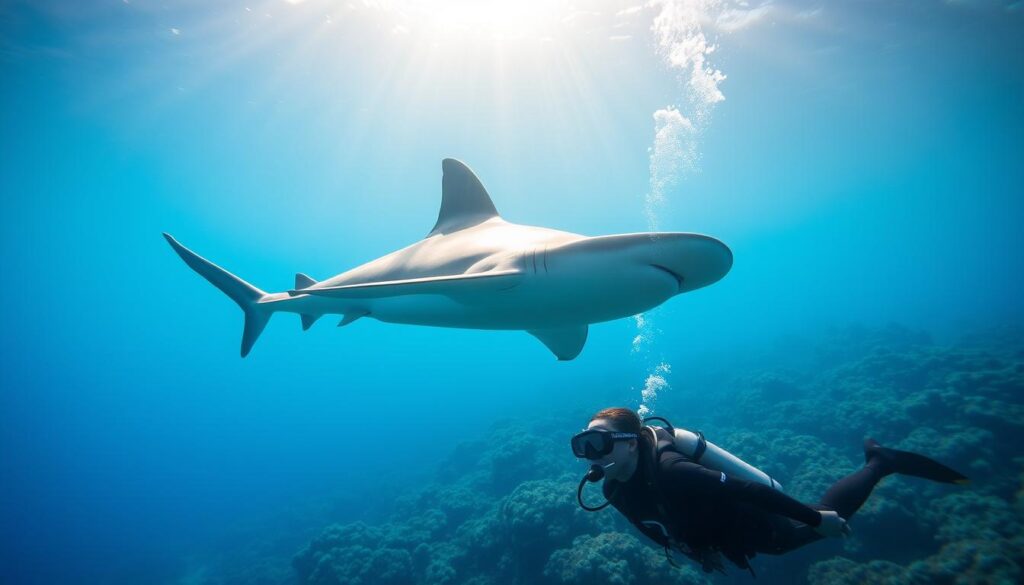
When diving with hammerhead sharks, remember to be respectful and knowledgeable. Also, having good guidance is key for exploring marine wildlife.
Hammerhead Shark Behavior Underwater
Marine wildlife is full of wonders, and hammerhead sharks are among the most fascinating. They have complex social structures and hunting tactics. These traits challenge our views of ocean predators.
Social Structure and Group Dynamics
Hammerhead sharks are known for their unique social behaviors. They often gather in large groups during the day. This creates stunning underwater scenes.
Their social dynamics include:
- Gathering in groups of up to 100 individuals
- Communicating through subtle body language
- Establishing complex hierarchical relationships
“Hammerhead sharks demonstrate a level of social complexity that continues to surprise marine researchers.” – Dr. Marine Biologist
Unique Hunting Strategies
The hammer-shaped head of these sharks is a big advantage in hunting. It lets them:
- Detect electrical impulses from prey
- Sweep the seafloor for hidden stingrays
- Navigate with extraordinary precision
Scalloped hammerhead sharks, critically endangered and reaching lengths up to 12 feet, showcase incredible diving capabilities. They can plunge to depths over 2,500 feet, demonstrating remarkable adaptability in challenging marine environments.
They have a special diet, mainly stingrays. Hammerheads use their heads to find and catch these prey. Their hunting is a mix of advanced senses and smart group tactics.
Common Marine Species Found Alongside Hammerhead Sharks
When diving with hammerhead sharks, you’ll often have the opportunity to encounter a diverse array of marine species that coexist in their habitats. These encounters not only enhance the overall diving experience but also provide a deeper understanding of the intricate web of life within the underwater ecosystem. Here are some common marine species you may encounter alongside hammerhead sharks:
- Manta Rays: Manta rays are graceful and majestic creatures often spotted in the same areas as hammerhead sharks. Their large wingspan and gentle movements make them a captivating sight. Observing the symbiotic relationship between mantas and hammerheads, where the sharks may follow mantas to feed on the disturbed prey, is a remarkable experience.
- Whale Sharks: While hammerhead sharks and whale sharks have distinct differences, it’s not uncommon to encounter these gentle giants in the same dive locations. Whale sharks, the largest fish in the sea, are known for their massive size and filter-feeding behavior. Witnessing the contrast between the colossal whale sharks and the sleek hammerheads creates a fascinating dynamic underwater.
- Turtles: Diving with hammerhead sharks often offers opportunities to encounter various species of sea turtles. Green turtles, hawksbill turtles, and loggerhead turtles are among the most commonly seen. Observing these ancient reptiles gracefully navigating through the water alongside the sharks adds to the richness of the diving experience.
- Schooling Fish: Hammerhead shark dives often take place near areas where schools of fish congregate. Silversides, jacks, and barracuda are just a few examples of fish species that can be observed in large numbers. The sight of shimmering silver schools of fish moving in unison, providing a mesmerizing backdrop to the hammerhead sharks, is a sight to behold.
- Moray Eels: The crevices and coral formations where hammerhead sharks gather can also be home to various species of moray eels. These enigmatic creatures, with their elongated bodies and powerful jaws, often peek out from their hiding spots, creating intriguing moments for divers.
- Reef Fish: Alongside hammerhead sharks, vibrant reef fish add bursts of color to the underwater landscape. Parrotfish, angelfish, butterflyfish, and triggerfish are just a few examples of the myriad species that call coral reefs home. Their intricate patterns and vibrant hues create a visual feast for divers during their encounters with hammerhead sharks.
- Pelagic Predators: The presence of hammerhead sharks often attracts other pelagic predators. Depending on the dive location, it’s possible to encounter species such as tiger sharks, bull sharks, or oceanic whitetip sharks. These apex predators contribute to the dynamic and thrilling nature of the dive, showcasing the diversity of the marine ecosystem.
Encountering these marine species alongside hammerhead sharks offers a holistic perspective on the interconnectedness of life in the ocean. Each creature plays a unique role in maintaining the delicate balance of the underwater ecosystem, and witnessing their interactions during a dive can be both awe-inspiring and educational.
Remember, when encountering marine species, it is important to maintain a respectful distance and avoid any disruptive behavior that may disturb their natural behavior or habitats. Adhering to responsible diving practices ensures that these incredible species can continue to thrive and inspire future generations of divers.
Conclusion: The Thrill of Hammerhead Diving
Extreme diving with hammerhead sharks is a life-changing experience. It connects adventurers with the ocean’s most amazing predators. By following eco-tourism, divers can make their underwater adventure a chance to help marine conservation.
Marine researchers have had incredible moments with hammerhead sharks. For example, at Talisey Point, they’ve seen schools of 30 to 200 sharks. These sightings show how vital it is to protect marine life and learn about shark behavior. Safe diving practices help both humans and sharks, supporting conservation efforts.
Encouraging Conservation Awareness
Diving with hammerhead sharks is a chance to help protect the sea. The Galapagos Islands, a UNESCO World Heritage Site, show how conservation can save marine habitats. By choosing responsible dive tourism, you support efforts against overfishing, pollution, and habitat loss.
Final Thoughts on Your Diving Adventure
Hammerhead shark diving is more than an adventure—it’s a deep connection with nature. Whether you dive in the Galapagos Islands or near Costa Rica and Panama, each dive is a chance to learn and protect marine life. Your dive can be a powerful way to show respect and commitment to ocean conservation.
FAQ – Diving with Hammerhead Sharks
Are hammerhead sharks dangerous to divers?
Hammerhead sharks are not usually aggressive towards humans. They are powerful predators, but attacks are rare. Hammerheads tend to avoid divers more than they approach them.
It’s important to follow safety rules and keep a safe distance. This way, you can enjoy seeing these amazing creatures underwater.
What equipment do I need for hammerhead shark diving?
You’ll need a good wetsuit, a reliable dive computer, and quality gear like a mask, fins, and regulator. For deeper dives, you might need technical diving equipment.
Photographers should bring a camera with a wide-angle lens and proper housing. Make sure your gear is in good shape and fits the diving conditions.
Where are the best locations to dive with hammerhead sharks?
Great places include the Galapagos Islands, Cocos Island in Costa Rica, Malpelo Island in Colombia, and the Red Sea. Each spot offers unique experiences, with shark sightings changing with the seasons.
Darwin and Wolf Islands in the Galapagos are famous for their huge hammerhead schools.
What is the best time of year to see hammerhead sharks?
The best time varies by location. In the Galapagos, June to November is best. The Red Sea is great from June to September. Cocos Island is best from May to November.
Always check with local guides and experienced operators for the latest information.
How can I contribute to hammerhead shark conservation?
You can help by choosing responsible dive operators and joining citizen science projects. Avoiding marine debris and spreading awareness about shark conservation are also important.
Supporting marine protected areas, joining conservation groups, and making eco-friendly travel choices can also help.
Do I need special certification for hammerhead shark diving?
You don’t need a “hammerhead diving” certification. But, most operators require advanced open water certification for deep dives. Some places might need deep diving or technical skills.
Always check the requirements of your dive location and operator.
How close can I get to hammerhead sharks?
Guides usually suggest staying at least 10-15 feet away. Be calm, move slowly, and avoid sudden actions. Let the sharks come to you if they’re interested.
Never chase or touch them. Respectful observation is the best way to enjoy these creatures.
What type of camera equipment works best for hammerhead photography?
Wide-angle lenses are best for capturing hammerheads in their environment. Mirrorless or DSLR cameras with good low-light performance are recommended. Cameras like the Sony A7 series or Canon EOS R work well.
Bring powerful strobes or video lights to capture details in the blue water.
